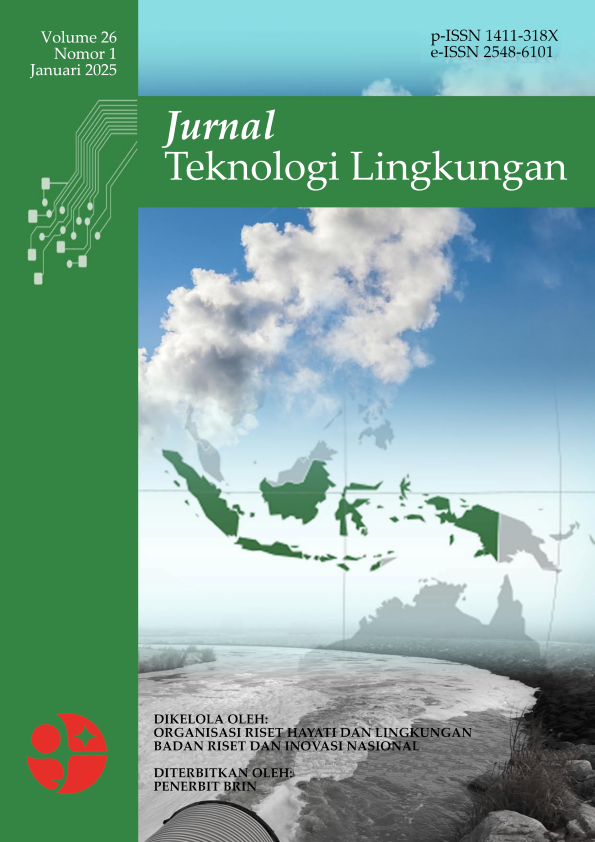Iif Miftahul Ihsan
Research Center for Environmental and Clean Technology, National Research and Innovation Agency, Kawasan Sains dan Teknologi BJ Habibie, Jl. Raya Puspiptek, Serpong, Tangerang Selatan, Banten 15314, Indonesia
Anies Ma'rufatin
Research Center for Hydrodynamics Technology, National Research and Innovation Agency, Kawasan Sains Said Djauharsjah Jenie-Kompleks ITS, Jl. Hidrodinamika, Sukolilo, Surabaya, East Java 60112, Indonesia
Nyayu Fatimah Zahroh
Research Center for Climate and Atmospheric, National Research and Innovation Agency, Kawasan Sains dan Teknologi Prof. Dr. Samaun Samadikun, Jl. Cisitu Sangkuriang, Bandung 40135, Indonesia
Iik Nurul Ikhsan
Research Center for Environmental and Clean Technology, National Research and Innovation Agency, Kawasan Sains dan Teknologi BJ Habibie, Jl. Raya Puspiptek, Serpong, Tangerang Selatan, Banten 15314, Indonesia
Nawa Suwedi
Research Center for Limnology and Water Resources, National Research and Innovation Agency, Kawasan Sains Terpadu Soekarno, Jl. Raya Jakarta Bogor Km 46, Cibinong, Bogor 16911, Indonesia
Reba Anindyajati Pratama
Research Center for Environmental and Clean Technology, National Research and Innovation Agency, Kawasan Sains dan Teknologi BJ Habibie, Jl. Raya Puspiptek, Serpong, Tangerang Selatan, Banten 15314, Indonesia
Rizky Pratama Adhi
Research Center for Environmental and Clean Technology, National Research and Innovation Agency, Kawasan Sains dan Teknologi BJ Habibie, Jl. Raya Puspiptek, Serpong, Tangerang Selatan, Banten 15314, Indonesia
Rendi Handika
Research Center for Geoinformatics, National Research and Innovation Agency, Kawasan Sains dan Teknologi Prof. Dr. Samaun Samadikun, Jalan Sangkuriang, Dago, Kecamatan Coblong, Bandung 40135, Indonesia
Akira Lusia
Research Center for Environmental and Clean Technology, National Research and Innovation Agency, Kawasan Sains dan Teknologi BJ Habibie, Jl. Raya Puspiptek, Serpong, Tangerang Selatan, Banten 15314, Indonesia
Masahide Nishihashi
National Institute for Environmental Studies, 16-2 Onogawa, Tsukuba, Ibaraki 305-8506, Japan; Meteorological Research Institute, 1-1 Nagamine, Tsukuba, Ibaraki 305-0052, Japan
Yukio Terao
National Institute for Environmental Studies, 16-2 Onogawa, Tsukuba, Ibaraki 305-8506, Japan
Shigeru Hashimoto
National Institute for Environmental Studies, 16-2 Onogawa, Tsukuba, Ibaraki 305-8506, Japan
Hideki Nara
National Institute for Environmental Studies, 16-2 Onogawa, Tsukuba, Ibaraki 305-8506, Japan
Hitoshi Mukai
National Institute for Environmental Studies, 16-2 Onogawa, Tsukuba, Ibaraki 305-8506, Japan
Abstract
The increasing concentration of PM2.5, PM10, and NO2 in urban areas will impact human health. Measuring and calculating the concentration of PM2.5, PM10, and NO2 is one of the efforts to control pollution because it can obtain information on the status or category of these air pollutants. Therefore, this study aims to analyze air quality, including PM2.5, PM10, and NO2 particulates calculated based on the Air Quality Index. Pollutant measurements are carried out continuously and in real-time for 24 hours. Pollutant measurements use a continuous dichotomous aerosol chemical speciation analyzer (ACSA-14) tool placed in the BJ Habibie Science and Technology Area, Serpong, South Tangerang. Analysis of PM2.5, PM10, and NO2 concentrations were analyzed to obtain the average daily concentration during the measurement period and the ISPU method was regulated in the Regulation of the Minister of Environment and Forestry Number 14 of 2020. During the measurement period, the daily average concentrations of PM2.5, PM10, and NO2 were 40.0 μg/m3, 60.4 μg/m3, and 37.4 μg/m3, respectively, with the highest concentrations of 170.8 μg/m3, 336.0 μg/m3, 647.5 μg/m3. The moderate and unhealthy categories dominated the results of the ISPU PM2.5 analysis during the measurement period, respectively, at 55.5% and 23.0%. The good and moderate categories dominate the ISPU PM10 and NO2 analysis results, namely 38.0% and 52.2% for PM10 and 82.5% and 7.5% for NO2, respectively.


